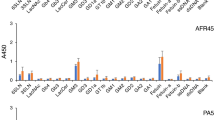Abstract
Based on the affinity for concanavalin A (Con A), human α1-acid glycoprotein (AGP) can be separated by chromatography on Con A-Sepharose gel into three variants: Con A unreactive AGP, Con A weakly reactive AGP, and Con A strongly reactive AGP. When exposed to native AGP or to its glycan variants, murine peritoneal macrophages released a factor that inhibited the interleukin-1 (IL-1) proliferative activity as measured in terms of the thymocyte comitogenic assay. Con A unreactive AGP, which contains tri- and tetraantennary glycans and no biantennae, proved to be more effective than Con A weakly and Con A strongly reactive variants, which contain one and two diantennary glycans, respectively. The inhibitory effect was not a function of the negative charge related to the sialyl residues and was not mediated by the maanosyl-fucosyl receptor.
Similar content being viewed by others
References
Chiu, K. M., R. F. Mortensen, A. P. Osmand, andH. Gewurz, 1977. Interactions of alpha-1-acid glycoprotein with the immune system. I. Purification and effects upon lymphocyte responsiveness.Immunology 32:997.
Bennett, M., andK. Schmid. 1980. Immunosuppression by human plasma α1-acid glycoprotein: Importance of the carbohydrate moiety.Proc. Natl. Acad. Sci. U.S.A. 77:6109.
Cheresh, D. A., D. H. Haynes, andJ. A. Distasio. 1984. Interaction of an acute phase reactant, α1-acid glycoprotein (orosomucoid), with the lymphoid cell surface: A model for non-specific immune reaction.Immunology 51:541.
Pos, O., R.Oostendorp, M. Van DerSielt, R.Sheper, and W. VanDur. Con A nonreactive humanα 1-acid glycoprotein (AGP) is more effective in modulation of lymphocyte proliferation than Con A-reactive AGP serum variants.Inflammation (in press).
Nicollet, I., J. P. Lebreton, M. Fontaine, andM. Hiron. 1981. Evidence for α1-acid glycoprotein populations of different pI values after concanavalin A affinity chromatography. Study of their evolution during inflammation in man.Biochim. Biophys. Acta 668:235.
Wells, C., T. C. Bog-Hansen, E. H. Cooper, andM. R. Glass. 1981. The use of concanavalin A crossed immunoaffinoelectrophoresis to detect hormone-associated variations in α1-acid glycoprotein.Clin. Chim. Acta 109:59.
Serbource-Goguel Seta, N., G. Durand, M. Corbic, J. Agneray, andJ. Feger. 1986. Alterations in relative proportions of microheterogenous forms of human α1-acid glycoprotein in liver disease.J. Hepatol. 2:245.
Bories, P. N., M. Guenounou, J. Feger, E. Kodari, J. Agneray, andG. Durand. 1987. Human α1-acid-glycoprotein-exposed macrophages release interleukin 1 inhibitory activity.Biochem. Biophys. Res. Commun. 147:710.
Biou, D., D. Konan, J. Feger, J. Agneray, G. Durand, Y. Leroy, P. Cardon, andB. Fournet. 1987. Alterations in the carbohydrate moiety of alpha-1-acid glycoprotein purified from human cirrhotic ascitic fluid.Biochim. Biophys. Acta 913:308.
Bayard, B., andJ. P. Kerckaert. 1980. Evidence for uniformity of the carbohydrate chains in individual glycoprotein molecular variants.Biochem. Biophys. Res. Commun. 95:777.
Laemmli, U. K. 1970. Cleavage of structural proteins during assembly of the head of bacteriophage T4.Nature 227:680.
Zanetta, J. P., W. C. Breckenridge, andG. Vincendon. 1972. Analysis of monosaccharides by gas-liquid chromatography ofO-methylglycosides as trifluoroacetates.J. Chromatogr. 69:291.
Gery I., R. Gershon, andB. Waksman. 1972. Potentiation of the T-lymphocyte response to mitogens. I. The responding cell.J. Exp. Med. 136:128.
Bierruhen, M., M. De Witt, C. Covers, W. Ferwerda, C. Koeleman, O. Pos, andW. Van Dijk. 1988. Glycosylation of three molecular forms of human α1-acid glycoprotein having different interactions with concanavalin A. Variations in the occurrence of di-, tri-, and tetraantennary glycans and the degree of sialylation.Eur. J. Biochem. 175:387.
Pimpaneau, V., P. Midoux, G. Durand, P. De Baetselier, M. Monsigny, andA. Roche. 1989. Endocytosis ofα 1acid glycoprotein variants and neoglycoproteins containing mannose derivatives by a mouse hybridoma cell-line (2c11–12). Comparison with mouse peritoneal macrophages.Glycoconjugate J. 6:561.
Stahl, P., andS. Gordon. 1982. Expression of a mannosyl/fucosyl receptor for endocytosis on cultured primary macrophages and their hybrids.J. Cell. Biol. 93:49.
Lejeune, P. J., B. Mallet, C. Farnarier, andS. Kaplanski. 1989. Changes in serum level and affinity for concanavalin A of human α1-proteinase inhibitor in severe burn patients: relationship to natural killer cell activity.Biochim. Biophys. Acta 990:122.
Ishizaka, K. 1986. T cell factors involved in the regulation of the IgE antibody response.In Advances in immunopharmacology. L. Chedid et al., editors. Pergamon Press, New York. 153–160.
Author information
Authors and Affiliations
Rights and permissions
About this article
Cite this article
Bories, P.N., Feger, J., Benbernou, N. et al. Prevalence of tri- and tetraantennary glycans of humanα 1-acid glycoprotein in release of macrophage inhibitor of interleukin-1 activity. Inflammation 14, 315–323 (1990). https://doi.org/10.1007/BF00915815
Issue Date:
DOI: https://doi.org/10.1007/BF00915815




